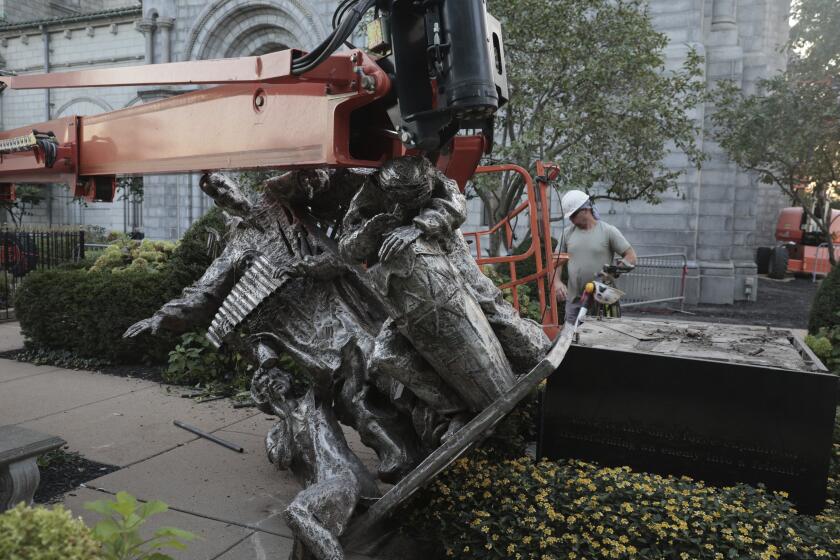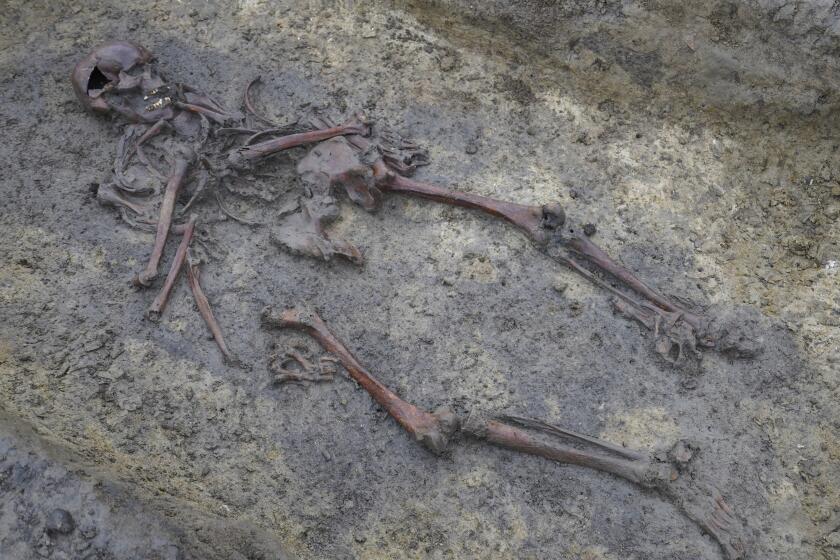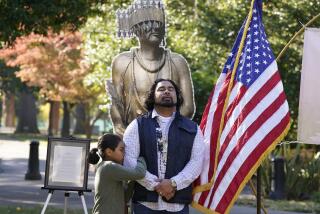St. Louis was once known as Mound City for its many Native American mounds. Just one remains

- Share via
ST. LOUIS — What is now St. Louis was once home to more than 100 mounds constructed by Native Americans — so many that St. Louis was once known as “Mound City.” Settlers tore most of them down, and just one remains.
Now, that last remaining earthen structure, Sugarloaf Mound, is closer to being back in the hands of the Osage Nation.
The city of St. Louis, the Osage Nation and the nonprofit Counterpublic announced on Thursday that an 86-year-old woman who owns a home that sits atop Sugarloaf Mound has agreed to sell it and eventually transfer the property to the tribe.
Meanwhile, the St. Louis Board of Aldermen plans to pass a resolution in January recognizing the Osage Nation’s sovereignty, Alderman Cara Spencer said. Eventually, the goal is to develop a cultural and interpretive center at the site that overlooks the Mississippi River a few miles south of downtown.
A noted sculpture that has stood for 25 years outside the Cathedral Basilica in St. Louis is badly damaged.
“One step for our tribal sovereignty is reclaiming the lands that we inhabited for hundreds of years,” said Andrea Hunter, director of the Osage Nation Historic Preservation Office in Pawhuska, Okla. “And to be able to at least salvage one mound in St. Louis, on the west side of the Mississippi River — it means a lot to us, to regain our heritage.”
But a sticking point remains. A pharmaceutical fraternity owns the only other house on the mound, and it remains unclear if it is willing to give up the property.
Native Americans built thousands of mounds across the U.S. in the centuries prior to colonization. All were sacred ceremonial sites, but some also were used for housing or commerce. Many were burial sites. Tribal elites sometimes lived on them, Hunter said.
The mounds in the St. Louis area are believed to have been built from roughly 800 to 1450. Even today, many mounds remain in nearby Cahokia, Ill. Experts believe that at one time centuries ago, Cahokia was home to up to 20,000 people.
A historic cemetery for enslaved people in the New York city of Kingston is being reclaimed as the Pine Street African Burial Ground.
Sugarloaf Mound and Big Mound were among the most prominent of the human-made structures in what is now St. Louis, said James McAnally, executive director of Counterpublic, a St. Louis nonprofit that works to affect change through art-based projects and helped facilitate the new land acquisition.
“They were built on the river specifically to be signal mounds,” McAnally said. Native Americans on the western side of the Mississippi could send smoke signals visible to those in Cahokia to let them know if people were seen coming down the waterway, Hunter said.
Mounds still stood prominently in St. Louis at its founding in 1764. Visitors — even members of European royalty — made the trip to the fledgling city just to see them, said Patricia Cleary, a U.S. history professor at Cal State Long Beach, and author of the book “Mound City: The Place of the Indigenous Past and Present in St. Louis.”
Eventually, removal treaties forced Native Americans away from St. Louis. Settlers had little use for the mounds.
Archaeologists in Denmark have unearthed a Viking Age burial ground containing some 50 “exceptionally well-preserved” skeletons.
“They used them to build up the bank of the Mississippi River and used them as fill for roads and railroads with total disregard for our ancestors’ graves that were in many of those,” Hunter said. “There are even accounts that as they were taking Big Mound down, they were simply throwing the bones into the Mississippi River.”
Today, St. Louis landmarks dot locations where mounds once stood, including several places in Forest Park, where mounds were demolished to make way for the World’s Fair in 1904. By the early 20th century, only Sugarloaf Mound remained.
In 2009, the Osage Nation purchased the first section of the mound, dismantled a home and began work to stabilize it. But two homes remained in private hands.
One of those homeowners, 86-year-old Joan Heckenberg, has agreed to transfer ownership to the Osage Nation once she either moves or dies.
Heckenberg has lived in the house 81 years, since her grandfather bought it and convinced his skeptical wife to move the family there.
Not long ago, you could stand atop giant earthen mounds built by prehistoric Indians and see the screen of an adult drive-in, ramshackle houses and a discount shoe store.
“But they fell in love with it,” Heckenberg said of her grandparents.
The agreement with Heckenberg leaves just one other private house on the mound, a building owned by Kappa Psi, a national pharmaceutical fraternity. Heckenberg said students haven’t lived there for years, and homeless people sometimes stay there.
A spokeswoman for the fraternity said a limited liability company manages the house and that selling it would be up to the LLC. She didn’t have the name or contact information for the LLC. McAnally said the fraternity has been approached about selling the home, but “so far they haven’t taken any action.”
Spencer said the mounds are an important and overlooked part of St. Louis, and preserving Sugarloaf is vital.
“This is a really special place to the Osage history and to our Native American heritage in this country, which has largely been erased,” Spencer said.
Salter writes for the Associated Press.
More to Read
Sign up for Essential California
The most important California stories and recommendations in your inbox every morning.
You may occasionally receive promotional content from the Los Angeles Times.












